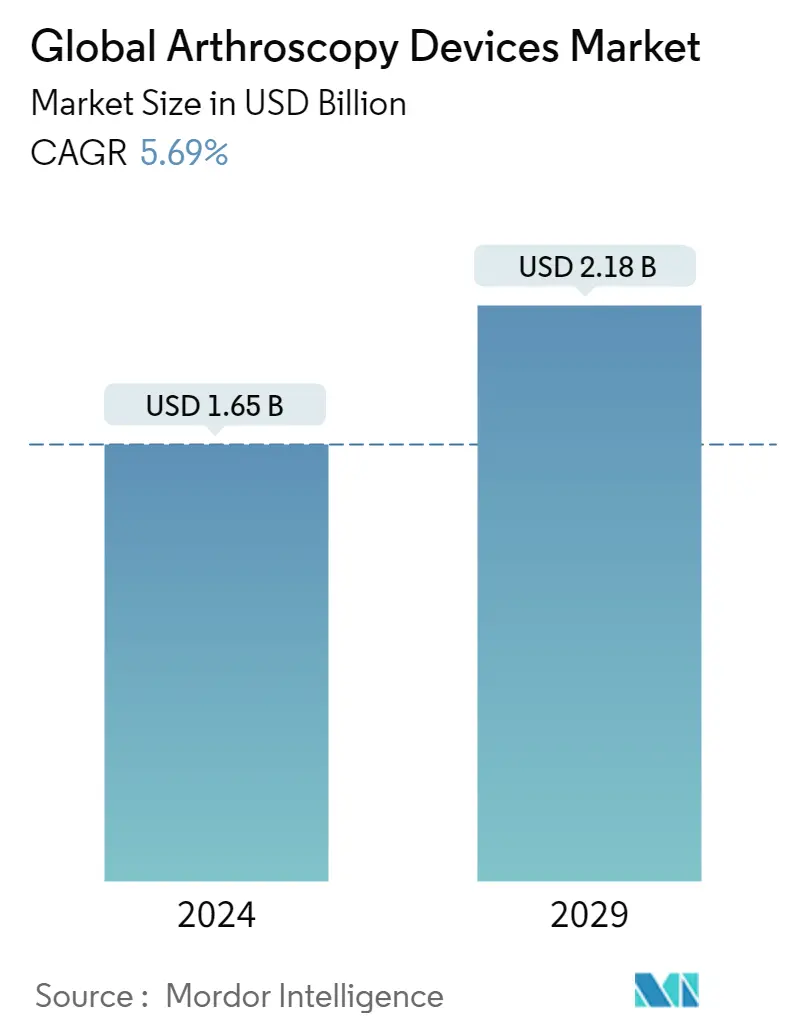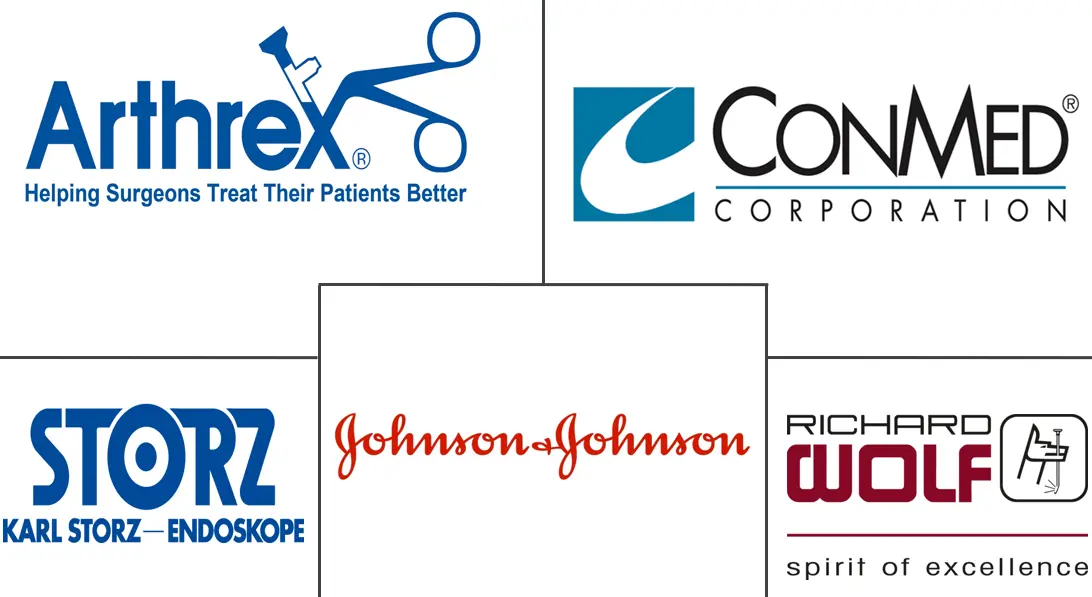Market Size of Global Arthroscopy Devices Industry

| Study Period | 2019 - 2029 |
| Market Size (2024) | USD 1.65 Billion |
| Market Size (2029) | USD 2.18 Billion |
| CAGR (2024 - 2029) | 5.69 % |
| Fastest Growing Market | Asia Pacific |
| Largest Market | North America |
Major Players
*Disclaimer: Major Players sorted in no particular order |
Arthroscopy Devices Market Analysis
The Global Arthroscopy Devices Market size is estimated at USD 1.65 billion in 2024, and is expected to reach USD 2.18 billion by 2029, growing at a CAGR of 5.69% during the forecast period (2024-2029).
The COVID-19 pandemic was an unprecedented public health concern and has negatively impacted the studied market. Preserving essential health care resources was prioritized in the wake of COVID-19, starting from mid-March 2020, wherein the surgeons were instructed to perform only the essential surgical operations. For instance, In April 2020, as per the Journal of Arthroplasty, an estimated 30,000 primary and 3,000 revision knee replacement surgeries were canceled every week in the early 2020. These numbers showcase the profound impact of COVID-19 on joint disorders surgeries. However, intensive efforts were being undertaken by several healthcare authorities, hospitals, and surgeons to restore the flow of arthroplasty procedures to pre-pandemic levels. ERAS programs (Enhanced Recovery after Surgery) were developed during a pandemic to shorten hospital stay, morbidity, and surgical complications. Furthermore, with the restored regular operating volume of surgeries, there were significant patient inflow due to postponing and cancelation of surgeries earlier. Hence, such changes in surgical practices has assisted in restoring the surgical volume post-COVID-19 pandemic.
Certain factors that are driving the market growth include increasing incidences of sports injuries, the rising geriatric population, and technological advancements in arthroscopic implants. Fractures, strains, sprains, and dislocations are the most common sports injuries. The usual self-treatment recommended for these injuries includes rest, ice, compression, and elevation (RICE). For serious injuries that need more attention, an arthroscopy could be recommended, depending on the situation. Injuries can occur in various places and can be of various types. Some of the common injuries include shoulder, hip, knee, elbow, wrist, or ankle injuries; cartilage tears or ligament injuries; inflammation of the lining of the joints; removal of loose fragments of bone or cartilage that become lodged in a joint; and osteoarthritis caused by cartilage loss in a joint. Some of these may require arthroscopic surgery, as it is helpful in their diagnosis and treatment.
In September 2020, According to the United States Centers for Disease Control (CDC), participation in organized sports is increasing. Each year, approximately 30 million children and adolescents participate in youth sports in the United States. Out of them, athletes from high schools account for an estimated 2 million injuries, 0.5 million doctor visits, and 30,000 hospitalizations, every year. Moreover, more than 3.5 million kids under the age of 14 years receive medical treatment for sports injuries, every year. Children between the age of 5-14 years account for nearly 40% of all sports injuries treated in hospitals. In the United States, injuries associated with participation in sports and recreational activities accounted for 25% of all traumatic brain injuries among children, in 2020. The above-mentioned statistics exhibit an increased number of injuries that require arthroscopy procedures, which is expected to have a positive impact on the market studied.
However, the average standard cost of an outpatient treatment using arthroscopic surgery for complicated tears can cost about USD 7,400-9,000, or even more, depending on the age of the patient, the severity and exact location of the injury, the related injuries, and on the hospital where the procedure is performed. The Agency for Healthcare Research and Quality sponsors a series of medical databases. One such database, namely, Healthcare Cost and Utilization, shows that an outpatient arthroscopic surgery typically costs USD 8,970. For insured patients, out-of-pocket costs typically consist of a specialist co-pay, i.e., mostly a hospital copay of USD 100 or more, and coinsurance of 10%-50% for the procedure, which could reach the yearly out-of-pocket maximum. In April 2020, According to the Kaiser Family Foundation, the average hospital copay is USD 132 for outpatient surgery, and USD 232 for inpatient surgery, and the average coinsurance rate is 17-18%. This shows that the average cost of arthroscopic procedures is very high, which could lead to people not opting for the procedure. Hence, high cost proves to be a potential restraint for the market.
Arthroscopy Devices Industry Segmentation
As per the scope of the report, arthroscopy devices are used to examine the bone joints for specific conditions, such as osteoarthritis, rheumatoid arthritis, tendinitis, and bone tumor. The increase in the prevalence of musculoskeletal disorders, due to the rapidly aging population, is the prime factor driving the demand for arthroscopy procedures. The arthroscopy devices market is expected to register a CAGR of 6% over the forecast period (2022-2027). The Arthroscopy Devices Market is Segmented by Application (Knee Arthroscopy, Hip Arthroscopy, Spine Arthroscopy, Shoulder and Elbow Arthroscopy, and Other Arthroscopy Applications), Product ( Arthroscope, Arthroscopic Implant, Fluid Management System, Radiofrequency (RF) System, Visualization System, Other Products), and Geography (North America, Europe, Asia-Pacific, Middle East, and Africa, and South America). The market report also covers the estimated market sizes and trends for 17 different countries across major regions, globally. The report offers the value (in USD million) for the above segments.
| Application | |
| Knee Arthroscopy | |
| Hip Arthroscopy | |
| Spine Arthroscopy | |
| Shoulder and Elbow Arthroscopy | |
| Other Arthroscopy Applications |
| Product | |
| Arthroscope | |
| Arthroscopic Implant | |
| Fluid Management System | |
| Radiofrequency (RF) System | |
| Visualization System | |
| Other Products |
| Geography | ||||||||
| ||||||||
| ||||||||
| ||||||||
| ||||||||
|
Global Arthroscopy Devices Market Size Summary
The arthroscopy devices market is poised for significant growth over the forecast period, driven by several key factors. The increasing incidence of sports injuries and the rising geriatric population are major contributors to the demand for arthroscopy procedures. Technological advancements in arthroscopic implants further bolster market expansion. The COVID-19 pandemic initially disrupted the market by postponing elective surgeries, but efforts to restore surgical volumes have been successful. Enhanced Recovery after Surgery (ERAS) programs have played a crucial role in minimizing hospital stays and complications, aiding the recovery of surgical volumes. The prevalence of joint disorders, particularly osteoarthritis, is also a significant driver, with knee arthroscopy becoming a common procedure to address these issues. The market is characterized by a competitive landscape with major players like Arthrex Inc., Conmed Corporation, and Johnson & Johnson (DePuy Synthes) holding substantial market shares.
In North America, the market is experiencing a notable increase in arthroscopy procedures, particularly for knee and hip surgeries. This rise is attributed to the growing prevalence of chronic diseases and orthopedic conditions among the aging population, as well as the increasing number of sports-related injuries. The high cost of arthroscopic procedures remains a potential restraint, but the demand continues to be fueled by the need for effective treatment options for joint disorders. The market's growth is further supported by strategic partnerships and technological innovations, such as the collaboration between Formus Labs and Zimmer Biomet. As the market evolves, the focus on developing advanced arthroscopy devices and expanding their global distribution is expected to drive further growth and competition among key industry players.
Global Arthroscopy Devices Market Size - Table of Contents
-
1. MARKET DYNAMICS
-
1.1 Market Overview
-
1.2 Market Drivers
-
1.2.1 Increasing Incidences of Sports Injuries
-
1.2.2 Rising Geriatric Population
-
1.2.3 Technological Advancements in Arthroscopic Implants
-
-
1.3 Market Restraints
-
1.3.1 Lack of Skilled Surgeons
-
1.3.2 Stringent Regulatory Requirements
-
1.3.3 High Cost of Arthroscopy Devices
-
-
1.4 Porter's Five Forces Analysis
-
1.4.1 Threat of New Entrants
-
1.4.2 Bargaining Power of Buyers/Consumers
-
1.4.3 Bargaining Power of Suppliers
-
1.4.4 Threat of Substitute Products
-
1.4.5 Intensity of Competitive Rivalry
-
-
-
2. MARKET SEGMENTATION (Market Size by Value - USD million)
-
2.1 Application
-
2.1.1 Knee Arthroscopy
-
2.1.2 Hip Arthroscopy
-
2.1.3 Spine Arthroscopy
-
2.1.4 Shoulder and Elbow Arthroscopy
-
2.1.5 Other Arthroscopy Applications
-
-
2.2 Product
-
2.2.1 Arthroscope
-
2.2.2 Arthroscopic Implant
-
2.2.3 Fluid Management System
-
2.2.4 Radiofrequency (RF) System
-
2.2.5 Visualization System
-
2.2.6 Other Products
-
-
2.3 Geography
-
2.3.1 North America
-
2.3.1.1 United States
-
2.3.1.2 Canada
-
2.3.1.3 Mexico
-
-
2.3.2 Europe
-
2.3.2.1 Germany
-
2.3.2.2 United Kingdom
-
2.3.2.3 France
-
2.3.2.4 Italy
-
2.3.2.5 Spain
-
2.3.2.6 Rest of Europe
-
-
2.3.3 Asia-Pacific
-
2.3.3.1 China
-
2.3.3.2 Japan
-
2.3.3.3 India
-
2.3.3.4 Australia
-
2.3.3.5 South korea
-
2.3.3.6 Rest of Asia-Pacific
-
-
2.3.4 Middle-East & Africa
-
2.3.4.1 GCC
-
2.3.4.2 South Africa
-
2.3.4.3 Rest of Middle-East & Africa
-
-
2.3.5 South America
-
2.3.5.1 Brazil
-
2.3.5.2 Argentina
-
2.3.5.3 Rest of South America
-
-
-
Global Arthroscopy Devices Market Size FAQs
How big is the Global Arthroscopy Devices Market?
The Global Arthroscopy Devices Market size is expected to reach USD 1.65 billion in 2024 and grow at a CAGR of 5.69% to reach USD 2.18 billion by 2029.
What is the current Global Arthroscopy Devices Market size?
In 2024, the Global Arthroscopy Devices Market size is expected to reach USD 1.65 billion.

